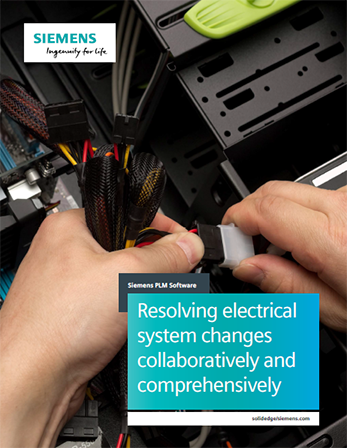Modernizing electrical system design

Electrical systems are extremely important in modern products. Modern products are loaded with electronics, enabling them to do amazing things:
- Perceive their physical environment
- Operate intelligently via circuit boards, processors, and embedded software
- Affect the physical world with motors and actuated components
- Communicate with the Internet of Things (IoT)

This level of intricacy is what makes the design of the electrical system so important. Supply too little power and electronics won’t run properly. Supply too much and a fuse will be blown or electronics will be damaged. Too little network bandwidth and data packets will be dropped, undermining control systems or efforts to leverage IoT analytics. Modern products simply don’t work without quality electrical systems.
Our latest eBook demonstrates how companies and engineers alike can more effectively respond to electrical system changes, and avoid unnecessary risks.
The collaborative, iterative design process
Electrical systems require intense design work by electrical engineers, but mechanical engineers play an important part as well: routing wires, sometimes bundling them together, through mechanical assemblies in a product.
The design process often progresses as follows:
Electrical design. Electrical engineers create the functional/logical design of the electrical system. They select the electrical components and connectors. They connect them with wires. They analyze the system to make sure it functions as intended.
At this point, electrical engineers have a fully defined electrical system, complete with information on which wires connect with which components and connectors.

Mechanical routing. Mechanical engineers take that information and start routing wires through the assembly. Information from the electrical engineer serves as a to-do list. It shows which wire starts at which component, and at which component it ends. Mechanical engineers can group wires together, creating a bundle to keep things organized. While routing, mechanical engineers will determine the best path to provide all the connections.

Design iteration and issue resolution. Even if wires are routed correctly through the assembly, the design isn’t quite finished. Some issues have to be identified and resolved. If a wire is too long, the signal may be too weak. If a high-power wire runs next to a signal wire it can cause interference. Electrical and mechanical engineers need to work collaboratively and iteratively to identify problems and resolve them during this phase.

Long story short, electrical and mechanical engineers need to work in concert to resolve issues. They have to identify which components or wires correspond to which components or wires in the mechanical assembly. This process, coupled with powerful software capabilities, allows them to diagnose and resolve issues quickly.
Simple design tools expose companies to risk
Companies are obviously rushing to produce smart, connected products and IoT advancements, which often leads them to design tools that are simple and readily accessible, perhaps already available in their organization. These often include:
- General-purpose diagramming applications to design electrical systems
- 2D computer-aided design (CAD) applications to route wires and harnesses
- Spreadsheet applications to build BOMs and perform engineering calculations
There’s no doubt about it, these tools can be used to design electrical systems. But that doesn’t take away from the fact that they have flaws relevant to the ways electrical and mechanical engineers collaborate that expose companies to risk.
Lack of handoff automation. Because these applications aren’t integrated, there’s no automation from electrical design to routing the system through the mechanical design.
Lack of iterative associativity. Lack of integration means changes by one engineer have to be manually assessed and interrogated by others.
Lack of interactivity. When engineers need to identify a wire or component in both the diagram and the mechanical assembly, these tools offer nothing. They’re disconnected, each one with unintelligent representations of wires and components.
These shortcomings are not only inconvenient; they can lead to serious problems. Inability to quickly resolve issues can lead to missing design release deadlines. Lack of support for collaborative work between engineers gets in the way, making it more likely that a design error can be communicated downstream.
Electrical design software in Solid Edge was developed to satisfy companies’ requirements
There are so many new ways to minimize risk with new technology. For manufacturers to meet demand and sustain quality, it’s critical to understand how to best integrate the mechanical and electrical aspects of their designs. Solid Edge electrical design applications are crafted to fit the needs of companies where easy-to-use and value are just as important as functionality.
Solid Edge is our portfolio of affordable software tools for product development. In electromechanical systems design, it provides the 3D mechanical assembly for routing wires and harnesses.
Solid Edge Wiring and Harness Design software helps engineers develop electrical schematics and collaborate directly with mechanical designs to optimize the overall design. The software provides data continuity from schematic to harness layout, enabling correct-by-construction design.
Solid Edge Electrical Routing allows engineers to efficiently create, route and organize wires, cables and bundles in Solid Edge assemblies.
In addition to these powerful applications and capabilities, they are also tightly integrated, offering several important advantages:
Automated handoffs. Information about the electrical system is handed off as a set into mechanical design, providing a to-do list of routing wires for the mechanical engineer.
Intelligent deliverable associativity. As items are added to one deliverable, they are intelligently included, as appropriate, in other deliverables.
Interactive highlighting. Solid Edge Electrical Routing enables cross-probing, which means that selecting a component in one application highlights it in the other application.

As an integrated solution, Solid Edge provides powerful capabilities to improve productivity. Our applications help engineers identify and resolve issues in electrical systems collaboratively and comprehensively, putting companies in the position to deliver projects on-time and on-budget.
“One of the biggest challenges to developing smart, connected products is resolving integration issues between electronics, electrical systems and mechanical design. The capability to easily pass information back and forth between electrical and mechanical engineers not only allows them to keep up to date with each other’s work, decreasing the likelihood of an integration issue, it also allows them to collaborate more easily when they do uncover a problem. The introduction of Solid Edge Wiring and Harness Design and its tight integration with traditional Solid Edge 3D MCAD is a good step in that direction.” —Chad Jackson, Principal Analyst @ Lifecycle Insights
Redefining electrical system design
Summing things up, in modern products, the design of electrical systems is crucial. Mechanical and electrical components must work together. There’s no way to ensure systems work together if design teams aren’t connected. When an issue is identified, companies need to know that engineers can collaborate to fix it.
Download Resolving electrical system changes collaboratively and comprehensively (eBook) by Siemens PLM Software to learn more about:
- Why electrical systems are so critical in modern products
- Collaborative and iterative design processes
- Common approaches to electromechanical design, and their challenges
- Strategies to support collaborative development




Comments